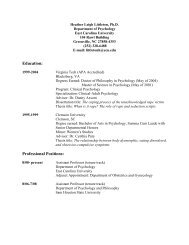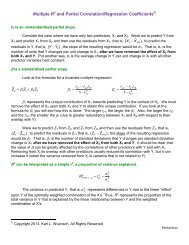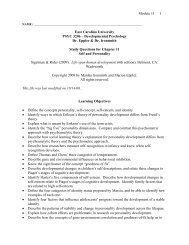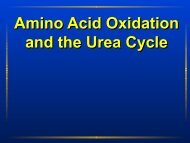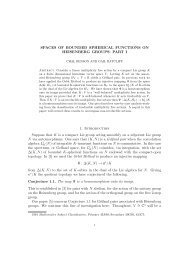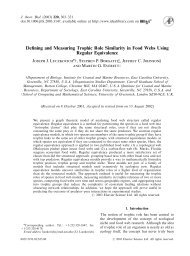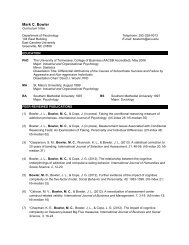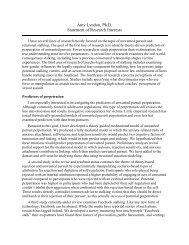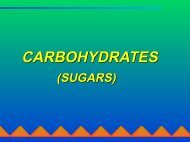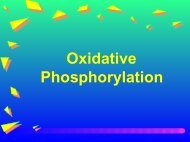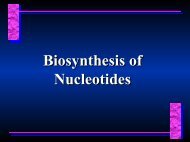Ketone Body Formation; Fatty acid and Cholesterol ... - Ecu
Ketone Body Formation; Fatty acid and Cholesterol ... - Ecu
Ketone Body Formation; Fatty acid and Cholesterol ... - Ecu
You also want an ePaper? Increase the reach of your titles
YUMPU automatically turns print PDFs into web optimized ePapers that Google loves.
<strong>Ketone</strong> <strong>Body</strong><br />
<strong>Formation</strong>; <strong>Fatty</strong> <strong>acid</strong><br />
<strong>and</strong> <strong>Cholesterol</strong><br />
Biosynthesis
• Most acetyl CoA from β-oxidation is<br />
routed through the TCA cycle<br />
• Excess is used to synthesize ketone bodies;<br />
β-hydroxybutyrate, acetoacetate <strong>and</strong><br />
acetone<br />
• <strong>Ketone</strong> bodies serve as fuel molecules<br />
• Liver is the site of synthesis in mammals<br />
(occurs in the mitochondrial matrix)
<strong>Ketone</strong> <strong>Body</strong> Synthesis:<br />
O<br />
H 3<br />
C-C-S-CoA<br />
Acetyl CoA<br />
+<br />
O<br />
H 3<br />
C-C-S-CoA<br />
Acetyl CoA
O<br />
H 3<br />
C-C-S-CoA<br />
Acetyl CoA<br />
+<br />
O<br />
H 3<br />
C-C-S-CoA<br />
Acetyl CoA<br />
HSCoA<br />
thiolase<br />
O<br />
O<br />
H 3<br />
C-C-CH 2<br />
-C-S-CoA<br />
Acetoacetyl CoA
O<br />
H 3<br />
C-C-S-CoA<br />
Acetyl CoA<br />
+<br />
O O<br />
H C-C-CH -C-S-CoA<br />
3 2<br />
Acetoacetyl CoA
O<br />
O<br />
O<br />
H 3<br />
C-C-S-CoA<br />
Acetyl CoA<br />
+<br />
H 3<br />
C-C-CH 2<br />
-C-S-CoA<br />
Acetoacetyl CoA<br />
HSCoA<br />
OH<br />
HMG CoA Synthase<br />
O<br />
-<br />
OOC-CH 2<br />
-C-CH 2<br />
-C-S-CoA<br />
CH 3<br />
3-Hydroxy-3-Methylglutaryl CoA (HMG CoA)
OH O<br />
-<br />
OOC-CH -C-CH -C-S-CoA<br />
2 2<br />
CH 3<br />
3-Hydroxy-3-Methylglutaryl CoA (HMG CoA)<br />
HMG CoA Lyase<br />
O<br />
H 3<br />
C-C-S-CoA<br />
Acetyl CoA<br />
O<br />
-<br />
OOC-CH 2<br />
-C-CH 3<br />
Acetoacetate
O<br />
-<br />
OOC-CH 2<br />
-C-CH 3<br />
Acetoacetate<br />
NADH<br />
β-Hydroxybutyrate<br />
D’Hase<br />
CO 2<br />
O<br />
CH 3<br />
-C-CH 3<br />
Acetone<br />
NAD + OH<br />
-<br />
OOC-CH -CH-CH 2 3<br />
β-Hydroxybutyrate
<strong>Ketone</strong> <strong>Body</strong> Breakdown:<br />
OH<br />
-<br />
OOC-CH 2<br />
-CH-CH 3<br />
β-Hydroxybutyrate<br />
*Liver enzyme catalyzes<br />
a near equilibrium<br />
reaction<br />
β-Hydroxybutyrate<br />
D’Hase<br />
*Isozyme found in<br />
other cells catalyzes<br />
an irreversible<br />
reaction<br />
NAD +<br />
NADH<br />
O<br />
-<br />
OOC-CH -C-CH 2 3<br />
Acetoacetate
O<br />
-<br />
OOC-CH 2<br />
-C-CH 3<br />
Acetoacetate<br />
Succinyl CoA Transferase<br />
+<br />
O<br />
-<br />
OOC-CH 2<br />
-CH 2<br />
-C-S-CoA<br />
Succinyl CoA<br />
O<br />
O<br />
H 3<br />
C-C-CH 2<br />
-C-S-CoA<br />
+<br />
-<br />
OOC-CH 2<br />
-CH 2<br />
-COO -<br />
Succinate<br />
Acetoacetyl CoA
O O<br />
H C-C-CH -C-S-CoA<br />
3 2<br />
Acetoacetyl CoA<br />
Thiolase<br />
O<br />
H 3<br />
C-C-S-CoA<br />
Acetyl CoA<br />
O<br />
H 3<br />
C-C-S-CoA<br />
Acetyl CoA
<strong>Fatty</strong> <strong>acid</strong><br />
Biosynthesis
• Occurs through the condensation of C2<br />
units<br />
• Occurs largely in adipocytes <strong>and</strong> liver<br />
<strong>and</strong> to a lesser extent in specialized<br />
tissues<br />
• Occurs in three stages: 1) transport of<br />
acetyl Co A to the cytosol; 2) formation<br />
of malonyl CoA; 3) assembly of the<br />
fatty <strong>acid</strong> chain
Citrate Transport System:<br />
Acetyl CoA + OAA<br />
Citrate<br />
α-Kg<br />
or<br />
malate<br />
Citrate:Dicarboxylic<br />
<strong>acid</strong> Carrier<br />
Cytosol<br />
Matrix
Citrate Transport System:<br />
Citrate<br />
Acetyl CoA + OAA<br />
Citrate<br />
α-Kg<br />
or<br />
malate<br />
Citrate:Dicarboxylic<br />
<strong>acid</strong> Carrier<br />
α-Kg<br />
or malate<br />
Cytosol<br />
Matrix
Citrate Transport System:<br />
citrate lyase<br />
malate<br />
d’hase<br />
Cytosol<br />
Citrate<br />
ATP<br />
ADP<br />
OAA + Acetyl CoA<br />
malate<br />
Malic<br />
enzyme<br />
NADH<br />
NAD+<br />
NADP+<br />
NADPH<br />
CO 2<br />
pyruvate<br />
Citrate:Dicarboxylic<br />
<strong>acid</strong> Carrier<br />
pyruvate<br />
translocase<br />
pyruvate<br />
Matrix
• <strong>Formation</strong> of Malonyl CoA by Acetyl CoA<br />
carboxylase<br />
• Loading Step: Transfer of<br />
acetyl CoA <strong>and</strong> malonyl CoA<br />
to ACP to form acetyl-ACP<br />
<strong>and</strong> malonyl ACP<br />
• Successive rounds of<br />
condensation; reduction;<br />
dehydration, reduction<br />
}<br />
<strong>Fatty</strong> Acid<br />
Synthetase
O<br />
H 3<br />
C-C-S-CoA<br />
acetyl-CoA<br />
+ HCO 3<br />
ATP<br />
ADP, Pi<br />
bicarbonate<br />
Acetyl CoA Carboxylase<br />
O<br />
-<br />
OOC-CH 2<br />
-C-S-CoA<br />
malonyl-CoA
<strong>Fatty</strong> Acid Synthetase Complex:<br />
Bacteria, Plants<br />
Seven activities in 7 separate proteins<br />
Yeast<br />
Seven activities in 2 separate proteins<br />
Vertebrates<br />
Seven activities in 1 large protein
acetyl-CoA<br />
O<br />
H 3<br />
C-C-S-CoA<br />
malonyl-CoA<br />
O<br />
-<br />
OOC-CH 2<br />
-C-S-CoA<br />
Acetyl CoA:ACP<br />
transacylase<br />
HS-ACP<br />
HS-CoA<br />
HS-ACP<br />
HS-CoA<br />
Malonyl CoA:ACP<br />
transacylase<br />
O<br />
H 3<br />
C-C-S-ACP<br />
acetyl-ACP<br />
O<br />
-<br />
OOC-CH 2<br />
-C-S-ACP<br />
malonyl-ACP<br />
Loading Step
O<br />
H 3<br />
C-C-S-ACP<br />
acetyl-ACP<br />
O<br />
-<br />
OOC-CH 2<br />
-C-S-ACP<br />
malonyl-ACP<br />
ketoacyl-ACP synthase<br />
Condensation
O<br />
H 3<br />
C-C-S-ACP<br />
acetyl-ACP<br />
O<br />
-<br />
OOC-CH 2<br />
-C-S-ACP<br />
malonyl-ACP<br />
CO 2<br />
HS-ACP<br />
ketoacyl-ACP synthase<br />
O O<br />
H C-C-CH -C-S-ACP<br />
3 2<br />
acetoacetyl-ACP<br />
Condensation
O<br />
O<br />
H 3<br />
C-C-CH 2<br />
-C-S-ACP<br />
acetoacetyl-ACP<br />
NADPH<br />
NADP +<br />
ketoacyl-ACP<br />
reductase<br />
OH<br />
O<br />
H 3<br />
C-C-CH 2<br />
-C-S-ACP<br />
H<br />
b-hydroxybutyryl-ACP<br />
Reduction
OH O<br />
H C-C-CH -C-S-ACP<br />
3 2<br />
H<br />
b-hydroxybutyryl-ACP<br />
b-hydroxyacyl-ACP<br />
dehydrase<br />
H 2<br />
0<br />
H O<br />
H C-C=C-C-S-ACP<br />
3<br />
H<br />
butenoyl-ACP<br />
Dehydration
H O<br />
H C-C=C-C-S-ACP<br />
3<br />
H<br />
butenoyl-ACP<br />
NADPH<br />
NADP<br />
+<br />
enoyl-ACP<br />
reductase<br />
O<br />
H 3<br />
C-CH 2<br />
-CH 2<br />
-C-S-ACP<br />
butyryl-ACP<br />
Reduction
• <strong>Fatty</strong> Acid Synthesis is sometimes called<br />
palmitate synthesis because palmitate is the<br />
predominant product (in mammals)<br />
• Rounds of synthesis continue until a C16<br />
palmitoyl group is formed<br />
• Thiolase then catalyzes the formation of<br />
palmitate <strong>and</strong> ACP-SH<br />
Palmitoyl-ACP<br />
thiolase<br />
Palmitate +<br />
ACP-SH
Overall stoichiometry for<br />
palmitate synthesis:<br />
Acetyl-CoA + 7 Malonyl CoA + 14 NADPH, H +<br />
palmitate + 7CoA + 7HCO 3<br />
14 NADP +
Regulation:<br />
• Key regulatory step: acetyl-CoA carboxylase<br />
• Citrate allosterically activates.<br />
• Palmitate is a feedback inhibitor<br />
• <strong>Fatty</strong> acyl-CoAs allosterically inhibit<br />
• Phosphorylation (stimulated by glucagon<br />
<strong>and</strong> epinephrine) inactivates
Regulation:<br />
• <strong>Fatty</strong> <strong>acid</strong> synthesis occurs in the<br />
chloroplast (stroma) in plants<br />
• The plant acetyl-CoA carboxylase is<br />
not regulated by phosphorylation; it<br />
is activated by increases in stromal<br />
pH <strong>and</strong> magnesium
• Synthesis of unsaturated fatty <strong>acid</strong>s requires the<br />
activity of a number of desaturases<br />
• Animal desauturases form double bonds as<br />
much as 9 carbons removed from the carboxyl<br />
end of a fatty <strong>acid</strong><br />
• Only plant desaturases form double bonds<br />
positioned farther than 9 carbons from the<br />
carboxyl end; thus fatty <strong>acid</strong>s such as linoleate<br />
(18:2 ∆9,12 ) must be acquired in the diet of animals<br />
<strong>and</strong> are considered essential fatty <strong>acid</strong>s
Linoleate<br />
arachidonic <strong>acid</strong> (C20:4 ∆5,8,11,14 )<br />
cyclooxygenase<br />
lipoxygenase<br />
leukotrienes<br />
eicosanoids<br />
prostagl<strong>and</strong>ins (smooth muscle<br />
contraction; pain; inflammation)<br />
trigger allergic<br />
responses
Linoleate<br />
arachidonic <strong>acid</strong> (C20:4 ∆5,8,11,14 )<br />
X<br />
cyclooxygenase<br />
lipoxygenase<br />
Aspirin<br />
eicosanoids<br />
prostagl<strong>and</strong>ins (smooth muscle<br />
contraction; pain; inflammation)<br />
leukotrienes<br />
trigger allergic<br />
responses
<strong>Cholesterol</strong> Biosynthesis<br />
• Pathway substantially active only in liver cells<br />
• All carbon atoms arise from acetyl-CoA<br />
• Squalene, C30 linear hydrocarbon, is an<br />
intermediate<br />
• Squalene is formed from 5 carbon units<br />
(isoprene)<br />
H 3<br />
C CH 2<br />
H 2<br />
C C C H
Stage 1: Acetyl Co-A to<br />
Isopentenyl Pyrophosphate<br />
2 Acetyl Co-A Acetoacetyl Co-A<br />
thiolase<br />
2 NADP +<br />
HS-CoA<br />
2<br />
NADPH<br />
HMG CoA<br />
HMG CoA<br />
synthase<br />
OH<br />
HMG CoA<br />
reductase<br />
-<br />
OOC-CH 2<br />
-C-CH 2<br />
-CH 2<br />
-OH<br />
CH 3<br />
Mevalonate
Stage 1: Acetyl Co-A to<br />
Isopentenyl Pyrophosphate<br />
2 Acetyl Co-A Acetoacetyl Co-A<br />
thiolase<br />
NADP +<br />
HS-CoA<br />
NADPH<br />
HMG CoA<br />
HMG CoA<br />
synthase<br />
OH<br />
X<br />
HMG CoA<br />
reductase<br />
-<br />
OOC-CH 2<br />
-C-CH 2<br />
-CH 2<br />
-OH<br />
CH 3<br />
Mevalonate<br />
Lovostatin<br />
(Mevacor);<br />
Zocor
OH<br />
-<br />
OOC-CH 2<br />
-C-CH 2<br />
-CH 2<br />
-OH<br />
melvalonate kinase<br />
CH 3<br />
Mevalonate<br />
ATP<br />
ADP, Pi<br />
OH<br />
Phosphomevalonate<br />
-<br />
OOC-CH -C-CH -CH -OPO<br />
=<br />
kinase<br />
2 2 2 3<br />
CH 3<br />
OH<br />
Phosphomevalonate<br />
-<br />
OOC-CH 2<br />
-C-CH 2<br />
-CH 2<br />
-OP 2<br />
O 6<br />
3-<br />
ATP<br />
ADP, Pi<br />
CH 3<br />
Pyrophosphomevalonate
Pyrophosphomevalonate<br />
ATP<br />
CH 3<br />
CH =C-CH -CH -OP O 3-<br />
2 2 2 2 6 Isopentenyl pyrophosphate<br />
Decarboxylase<br />
ADP, Pi<br />
CO 2<br />
isomerase<br />
CH 3<br />
CH -C=CH-CH -OP O 3-<br />
3 2 2 6 Dimethylallyl pyrophosphate
Stage 2: Isopentenyl Pyrophosphate to<br />
Squalene<br />
Isopentenyl pyrophosphate +<br />
Dimethylallyl pyrophosphate<br />
prenyl transferase<br />
condense head to tail<br />
PPi<br />
OP 2<br />
O 6<br />
3-<br />
Geranyl<br />
pyrophosphate<br />
(C10)
OP 2<br />
O 6<br />
3-<br />
Geranyl<br />
pyrophosphate<br />
(C10)<br />
+<br />
OP 2<br />
O 6<br />
3-<br />
Isopentenyl<br />
pyrophosphate<br />
(C5)<br />
prenyl transferase<br />
OP 2<br />
O 6<br />
3-<br />
PPi<br />
Farnesyl<br />
pyrophosphate<br />
(C15)
2 PPi<br />
OP 2<br />
O 6<br />
3-<br />
NADPH<br />
2 Farnesyl<br />
pyrophosphates<br />
condense head to head<br />
NADP +<br />
Reaction catalyzed<br />
by Squalene<br />
synthase<br />
Product is Squalene (C30) !
Stage 3: Squalene to <strong>Cholesterol</strong><br />
• Numerous steps involving addition of oxygen (to<br />
form squalene 2,3 epoxide) <strong>and</strong> closure of rings<br />
• Lanosterol is the first intermediate containing all<br />
four fused rings; it accumulates in large amounts<br />
in cells actively synthesizing cholesterol<br />
• Lanosterol is converted to cholesterol in 20<br />
more reactions<br />
• Squalene 2,3 epoxide is precursor to plant<br />
sterols
<strong>Cholesterol</strong> metabolism is a source of a large<br />
number of other cellular constituents:<br />
• Isopentenyl pyrophosphate is precursor to fat<br />
soluble vitamins (A, E, K), ubiquinone in<br />
animal cells, plastoquinone <strong>and</strong> the phytol side<br />
chain of chlorophyll in plant cells, certain oils<br />
such as musk, lemon, eucalayptus<br />
• <strong>Cholesterol</strong> is precursor for bile salts, vitamin<br />
D, steroid hormones, mineralocorticoids, <strong>and</strong><br />
is also an important component of membranes.
Regulation of HMG-CoA Reductase:<br />
• Phosphorylation by c-AMP dependent<br />
protein kinase inactivates.<br />
• Gene expression: <strong>Cholesterol</strong> levels<br />
control the amout of mRNA. If [cholesterol]<br />
is high, mRNA levels are reduced. If<br />
[cholesterol] is low, mRNA is increased.<br />
• Degradation of the enzyme: Half-life depends<br />
upon the cholesterol level; high cholesterol<br />
means a short half-life.
Lipoproteins: Good vs. Bad <strong>Cholesterol</strong><br />
Phospholipids, triacylglycerols <strong>and</strong> cholesterol circulate<br />
in blood in the form of lipoproteins.<br />
Classified according to the relative amounts of lipid<br />
<strong>and</strong> protein in the complex (the more protein <strong>and</strong> less<br />
lipid the denser the complex).<br />
Thus, we have high-density lipoproteins (HDL);<br />
low-density lipoproteins (LDL); intermediate-density<br />
lipoproteins (IDL); very-low density lipoproteins (VLDL)<br />
<strong>and</strong> chylomicrons.
All lipoproteins consist of a core of triacylglycerols or<br />
cholesterol esters surrounded by a single phospholipid<br />
layer into which is inserted a mixture of cholesterol <strong>and</strong><br />
proteins. The proteins serve as recognition sites for<br />
lipoprotein receptors throughout the body.<br />
HDL <strong>and</strong> VLDL are synthesized primarily in the ER of the<br />
liver; chylomicrons are synthesized in the intestine.<br />
LDL is synthesized from VLDL <strong>and</strong> is the major<br />
circulatory complex for transport of cholesterol <strong>and</strong><br />
cholesterol esters from liver to other tissues.<br />
Chylomicrons transport triacylglycerols mostly (<strong>and</strong><br />
some cholesterol esters) from intestines to other tissues.
VLDL released in to the bloodstream is converted to IDL<br />
<strong>and</strong> LDL by the action of lipases which cleave<br />
triacylglycerols.<br />
The half-life of LDL is about 24 hours. It is removed from<br />
circulation by endocytosis in coated vesicles <strong>and</strong><br />
degradation by lysosomal <strong>acid</strong> lipases.<br />
HDL has a half-life of 5-6 days. Newly formed HDL contains<br />
no cholesterol esters. These accumulate over time through<br />
the action of enzymes that transfer cholesterol esters. HDL<br />
functions to return cholesterol <strong>and</strong> cholesterol esters to the<br />
liver <strong>and</strong> hence remove them from circulation. Hence, HDL<br />
is the “good cholesterol”. LDL, because it is the major<br />
circulating form of cholesterol is the “bad cholesterol”<br />
correlated with increased risk of cardiovascular disease.
Receptor-Mediated Endocytosis<br />
Discovered by Brown <strong>and</strong> Goldstein (1985 Nobel<br />
Prize).<br />
ApoB-100, the major protein in LDL particles, is<br />
recognized by the LDL receptor.<br />
Binding of LDL to the LDL receptor initiates<br />
endocytosis which brings LDL <strong>and</strong> its receptors into<br />
the cell inside an endosome.<br />
Endosomes fuse with lysosomes, which contain<br />
enzymes that hydrolyze cholesterol esters, releasing<br />
cholesterol <strong>and</strong> fatty <strong>acid</strong>s into the cytosol.
ApoB-100 is degraded to amino <strong>acid</strong>s, but the LDL<br />
receptor is recycled back to the cell surface.<br />
<strong>Cholesterol</strong> entering the cell in this manner is used<br />
to synthesize membranes, or is reesterified for<br />
storage in cytosolic lipid droplets.<br />
Defective LDL receptors result in the genetic disease<br />
familial hypercholesterolemia. This is characterized<br />
by the inability of cells to take up cholesterol; hence<br />
blood cholesterol levels are extremely high.<br />
The excess blood cholesterol accumulates <strong>and</strong><br />
contributes to the formation of atherosclerotic<br />
plaques. Heart failure from atherosclerosis is the<br />
leading cause of death in industrialized societies.
Coated pit<br />
Clathrin<br />
Receptor with lig<strong>and</strong><br />
Adaptor



